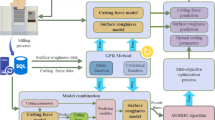Abstract
The aim of this study is to develop an integrated study of surface roughness to model and optimize the cutting parameters when end milling of AISI 1040 steel material with TiAlN solid carbide tools under wet condition. A multiple regression analysis using analysis of variance is conducted to determine the performance of experimental measurements and to show the effect of four cutting parameters on the surface roughness. Artificial neural network (ANN) based on Back-propagation (BP) learning algorithm is used to construct the surface roughness model exploiting a full factorial design of experiments. Genetic algorithm (GA) supported with the tested ANN is utilized to determine the best combinations of cutting parameters providing roughness to the lower surface through optimization process. GA improves the surface roughness value from 0.67 to 0.59 μm with approximately 12% gain. Then, machining time has also decreased from 1.282 to 1.0316 min by about 20% reduction based on the cutting parameters before and after optimization process using the analytical formulas. The final measurement experiment has been performed to verify surface roughness value resulted from GA with that of the material surface by 3.278% error. From these results, it can be easily realized that the developed study is reliable and suitable for solving the other problems encountered in metal cutting operations as the same as surface roughness.
Similar content being viewed by others
References
Boothroyd G, Knight WA (1989) Fundamentals of machining and machine tools. Marcel Dekker Inc., New York
Dagnal H (1986) Exploring surface texture. Rank Taylor Habson Corp., England
Urbanski JP, Koshy P, Dewes RC, Aspinwall DK (2000) High speed machining of mold and dies for net shape manufacture. Mater Des 2:395–402
Koshy P, Dewes RC, Aspinwall DK (2002) High speed end milling of hardened AISI D2 tool steel (~58 HRC). J Mater Process Technol 127:266–273, doi:10.1016/S0924-0136(02)00155-3
Huang BP, Chen JC (2003) An in-process neural network-based surface roughness prediction (INN-SRP) system using a dynamometer in end milling operations. Int J Adv Manuf Technol 21:339–347, doi:10.1007/s001700300039
Mansour A, Abdalla H (2002) Surface roughness model for end milling: a semi-free cutting carbon casehardening steel (EN 32) in dry condition. J Mater Process Technol 124:183–191, doi:10.1016/S0924-0136(02)00135-8
Reddy NS, Rao PV (2005) Selection of optimum tool geometry and cutting conditions using a surface roughness prediction model for end milling. Int J Adv Manuf Technol 26:1202–1210, doi:10.1007/s00170-004-2110-y
Huang BP, Chen JC (2008) Artificial-neural-network-based surface roughness Pokayoke system for end-milling operations. Neurocomputing 71:544–549, doi:10.1016/j.neucom.2007.07.029
Benardos PG, Vosniakos GC (2002) Prediction of surface roughness in CNC face milling using neural networks and Taguchi’s design of experiments. Rob Comput Integr Manuf 18:343–354, doi:10.1016/S0736-5845(02)00005-4
Nalbant M, Gökkaya H, Toktaş I, Sur G (2008) The experimental investigation of the effects of uncoated, PVD-and CVD-coated cemented carbide inserts and cutting parameters on surface roughness in CNC turning and its prediction using artificial neural networks. Rob Comput Integr Manuf (in press)
Zhong ZW, Khoo LP, Han ST (2006) Prediction of surface roughness of turned surfaces using neural networks. Int J Adv Manuf Technol 28:688–693, doi:10.1007/s00170-004-2429-4
Briceno JF, Mounayri HE, Mukhopadhyay S (2002) Selecting an artificial neural network for efficient modelling and accurate simulation of the milling process. Int J Mach Tools Manuf 42:663–674, doi:10.1016/S0890-6955(02)00008-1
Özel T, Karpat Y, Figueira L, Davim JP (2007) Modelling of surface finish and tool flank wear in turning of AISI D2 steel with ceramic wiper inserts. J Mater Process Technol 189:192–198, doi:10.1016/j.jmatprotec.2007.01.021
Jesuthanam CP, Kumanan S, Asokan P (2007) Surface roughness prediction using hybrid neural networks. Mach Sci Technol 11:271–286, doi:10.1080/10910340701340141
Song RG, Zhang QZ (2001) Heat treatment technique optimization for 7175 aluminum alloy by an artificial neural network and a genetic algorithm. J Mater Process Technol 117:84–88, doi:10.1016/S0924-0136(01)01114-1
Srinivas V, Ramanjaneyulu K (2007) An integrated approach for optimum design of bridge decks using genetic algorithms and artificial neural networks. Adv Eng Software 38:475–487, doi:10.1016/j.advengsoft.2006.09.016
Cus F, Balic J (2003) Optimization of cutting process by GA approach. Rob Comput Integr Manuf 19:113–121, doi:10.1016/S0736-5845(02)00068-6
Iscur (2006) Cutting tool material and catalogue. IS-CUT, Israel
Coromant S (2005) New tools from sandvik, tool catalogue. AB Sandvik Coromant, Sweeden
Lippman RP (1987) An introduction to computing with neural nets. IEEE ASSP 4:4–22, doi:10.1109/MASSP.1987.1165576
Anderson D, McNeil G (1992) Artificial neural network technology. Kaman Sciences Corporation
Math Works Incorporation (2005) Matlab user manual version 7.1 R14. Math Works Inc., Natick, MA
David LC (1997) Genetic algorithms. University of Illinois, Champaign
Goldberg DE (1989) Genetic algorithms in search, optimization and machine learning. Addison-Wesley, Reading, New York
Ozcelik B, Oktem H, Kurtaran H (2005) Optimum surface roughness in end milling Inconel 718 by coupling neural network and genetic algorithm. Int J Adv Manuf Technol 27:234–241, doi:10.1007/s00170-004-2175-7
Author information
Authors and Affiliations
Corresponding author
Rights and permissions
About this article
Cite this article
Öktem, H. An integrated study of surface roughness for modelling and optimization of cutting parameters during end milling operation. Int J Adv Manuf Technol 43, 852–861 (2009). https://doi.org/10.1007/s00170-008-1763-3
Received:
Accepted:
Published:
Issue Date:
DOI: https://doi.org/10.1007/s00170-008-1763-3




